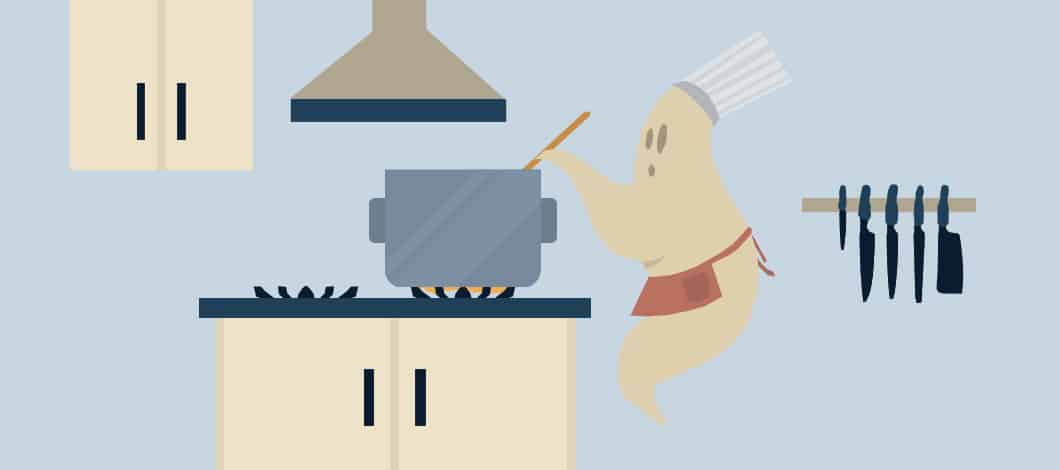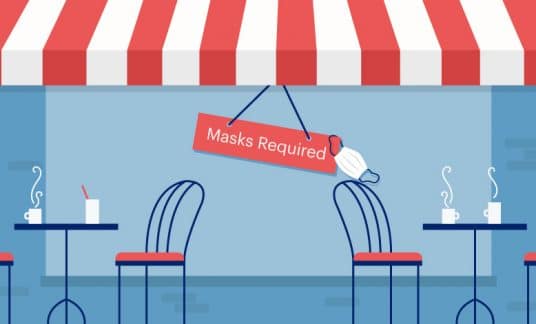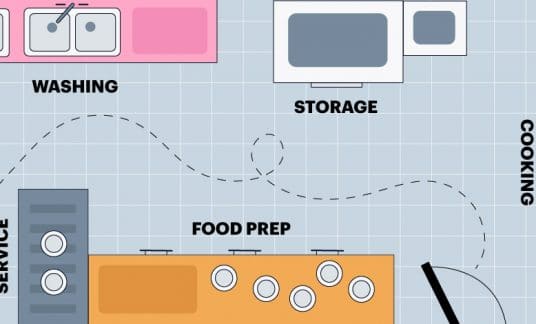What is a ghost kitchen and why are they becoming so popular? Although online- and delivery-only restaurants aren’t new, the pandemic fueled their growth.
For many restaurateurs, a virtual kitchen can add a much-needed income stream to existing operations. Others see a ghost restaurant as a unique startup opportunity.
Learn what’s behind the boon — and how you can succeed in your endeavors.
What Is a Ghost Restaurant?
A ghost kitchen is a delivery-only restaurant. It may be a standalone business or housed in a rentable warehouse-type space or exist within another restaurant. Other terms for online-only restaurants include cloud or dark kitchens, shadow kitchens or commissary kitchens.
A delivery-only facility doesn’t offer customer dining spaces or pick-up services. Instead, it accepts orders via websites, telephone or food-delivery apps, such as Uber Eats or Grubhub. Once ghost kitchen companies receive orders, they prepare them onsite and send them out for delivery.
Companies such as DoorDash Kitchens and Kitchen United offer rentable kitchen spaces for budding entrepreneurs. More prominent brands, like Chili’s, share their kitchen with its smaller brand, Just Wings.
Similar to conventional restaurants, online-only companies face a third-party delivery dilemma. They can cut costs and keep control over the final mile by employing their own drivers. However, delivery services increase brand visibility and help restaurants expand their audience.
Behind the Online Restaurant Boom
On a smaller scale, restaurant owners have shared commercial kitchen space with independent chefs for years. NBC New York’s investigation of the top 100 Grubhub and Seamless restaurants in 2015 “found slightly more than 10% of the kitchens were ghosts.”
As global delivery sales more than doubled between 2014 and 2019 more ghost kitchens popped up. A number that only increased during the pandemic. Eater San Francisco reports that, “Uber Eats has grown by 190%” in 2020 compared with the third quarter of 2019.
According to Statista, “The global cloud kitchen market size was estimated at $43.1 billion in 2019 and is forecast to reach $71.4 billion by 2027.” As of July 2020, Euromonitor says there were an estimated 1,500 ghost kitchens.
Furthermore, “By 2030, ghost kitchens are predicted to hold a 50% share of the drive-thru and takeaway foodservice markets, respectively,” according to Statista. But they’ll also take a bite out of ready meals, packaged cooking ingredients, dine-in food service and packaged snacks segments.

Ghost Kitchen Companies: Pros and Cons
Although ghost kitchens can be a lifeline for companies wanting multiple brands to coexist under one roof, entrepreneurs should consider the pros and cons of the project. While ghost restaurants provide several advantages, there are potential drawbacks.
Before developing a ghost kitchen concept, consider what you can get from it and how to minimize your risks.
The Benefits of Opening a Ghost Kitchen
Ghost kitchens allow restaurateurs to test a new idea, menu, and brand with less cost and risk. A digital-first space requires a smaller footprint, possibly reducing fixed costs, such as utilities and rent.
For instance, Restaurant Dive reports, Wingstop’s first ghost kitchen “is under 400 square feet—less than a quarter of the size of a typical Wingstop unit—and only facilitates delivery orders.”
Delivery-only restaurants also provide labor savings. Owners don’t need a front-of-the-house staff. They can hire delivery teams or outsource it to a third-party service.
Plus, with a kitchen optimized to only cook and package delivery orders, a smaller team can process many more food tickets than a regular kitchen.
Other advantages of opening a ghost kitchen include:
- Flexibility to change the menu or branding based on guest trends and demand
- There are no restrictions on how many guests you can seat or serve
- Ghost kitchens are quicker and simpler to launch
- It can serve as a test concept before starting a brick-and-mortar restaurant
- Restaurants can open a small delivery-only second location to expand their market
The Potential Disadvantages of Starting a Ghost Restaurant
The food and beverage industry is risky regardless of the segment or concept, and ghost restaurants aren’t any different. Without a physical storefront, owners may spend more money to build and market their brand online.
Challenges consist of:
- Paying third-party food delivery apps up to 40% of your earnings
- Difficulty creating and retaining a loyal customer base without face-to-face interactions
- A lack of access to customer data when using third party systems
- Identifying market demand for food that travels well
- A loss of control over the final mile of delivery
- More stringent management of your online reputation
- Finding a location that doesn’t hinder delivery times
- High-level competition from huge organizations and delivery services
Creating a Ghost Kitchen Concept
Whether you’re just starting or are the owner of a brick-and-mortar restaurant, ghost kitchens require careful planning. It’s essential to run the numbers and determine your best options. Although a ghost kitchen startup can be less work than a conventional restaurant, you’ll complete many of the same initial steps.
Location Still Matters
Your options include shared commercial areas, standalone buildings or leasing a DoorDash ghost kitchen space. But you should consider the barriers drivers may face when delivering within your area. Train crossings or congested traffic when pulling out of your parking lot can make sites less desirable.
Moreover, you’ll want dedicated space for delivery driver parking and an indoor area suitable for storing orders for mistake-free pick-ups. On the inside, take a look at the existing restaurant floor plan and equipment to determine remodeling expenses. It also helps if there’s a centrally located office overlooking the kitchen.
Plan Your Ghost Kitchen Layout Carefully
Setting up a ghost kitchen can be easier than conventional restaurant layouts. Get the most out of a small space and ensure your design is flexible enough to support multiple ghost brands. To this end, modular equipment and work tables function better than permanent fixtures.
Typically, ghost kitchens feature 1 or 2 cooking lines outfitted with countertop cooking equipment, large exhaust hoods and combination ovens. There should be ample prep space for packaging items. In short, it should function well for a small number of staff members from order intake to placing the order in a delivery cubby.
Ghost Kitchen Menu Considerations
Simple is better than complicated for delivery-only restaurants. It can keep your costs lower, reduce waste and increase efficiency. Along with ensuring your delivery area can support your food style and concept, restaurateurs should think about:
- Prep times for dishes
- Food temperature requirements during delivery
- The appearance of items in to-go containers
- Quality and taste
Delivery-Only Kitchens: Branding and Promotion
Once you’ve designed your restaurant kitchen concept, foundational branding should take center stage. Pay special attention to your logo and colors, as customers will only gain brand recognition by seeing a strong visual icon on the packaging.
The bag, containers, cups and labels should provide an at-home delivery experience that differentiates your virtual kitchen brand from others. Consider sending a flyer or coupon with orders to encourage repeat visits or ask for a review.
Menu design must be an extension of your brand yet be easy to navigate and read on mobile and desktop devices. At the same time, your website should humanize your brand via storytelling and high-quality photography.
Your marketing plan should concentrate heavily on your online audience. Take advantage of social media channels such as Instagram and Facebook, Yelp and Google My Business profiles.

Tips for Ghost Kitchen Success
You won’t make a memorable impression in person, so your online assets must provide frictionless experiences. Kitchen designers, branding professionals and marketing experts can help you get a jumpstart on success.
Develop a practical and profitable ghost restaurant using the following best practices:
- Do your research: Assess your market, expansion opportunities and potential profit. A ghost kitchen calculator can help you develop a realistic plan.
- Prioritize integrations: Select point-of-sale (POS) and customer-relationship-management (CRM) systems that connect to your website’s online ordering tools and third-party applications.
- Leverage proximity software: Use location-based mapping services to find the best delivery routes, including back-office and mobile applications.
- Enhance customer experience: Provide delivery tracking tools and create a seamless, branded experience from digital touchpoints to your physical food and beverage products.
- Consider other income streams: Look for opportunities to use basic ingredients in various cuisine styles so you can add more delivery-only brands using your existing space and supplies.
Ghost Restaurants: The Future Is Now
There are many reasons why first-time and experienced entrepreneurs open a ghost kitchen. But the bottom line is that demand for delivery isn’t going away — and restaurants are still struggling to make ends meet.
Ghost restaurants may be an opportunity that’s too good to pass up.










